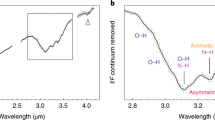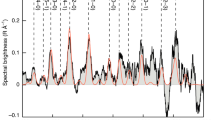Abstract
The discovery of Comet IRAS–Araki–Alcock provided the first opportunity for studying a comet at a distance of 4.5 × 106 km from the Earth, thus allowing a spatial resolution of ∼20 km to be achieved. Photographic and spectroscopic plates obtained on 9.9 UT May 1983 using the 90-cm Schmidt and the 182-cm Coper-nicus telescopes at the Asiago Observatory have revealed new fundamental discoveries. The photometric data system (PDS)-elaborated Schmidt plates show that the inner coma of the comet is directed towards the Sun with an inclination of ∼30°, a phenomenon probably due to the rotation of the nucleus. On the spectroscopic plates taken with the grating spectrograph in the spectral range 3,800–8,500 Å with a resolution of 6 Å, 450 lines can be distinguished, although 90 lines are still unidentified. After detailed analysis, we have identified the molecules HCO and H2S+ which have never before been observed in the visible part of the spectrum of any astronomical object. We suspect that H2CO, DCO, S2 and NH4 are also present. We report here only the preliminary results from our spectroscopic data.
This is a preview of subscription content, access via your institution
Access options
Subscribe to this journal
Receive 51 print issues and online access
$199.00 per year
only $3.90 per issue
Buy this article
- Purchase on Springer Link
- Instant access to full article PDF
Prices may be subject to local taxes which are calculated during checkout
Similar content being viewed by others
References
Walker, R. G. et al. Astrophys. J. Lett. 278, L11 (1984).
A'Hearn, M. F., Feldman, P.D. & Schleicher, D. G. Astrophys. J. Lett. 274, L176 (1983).
Altenhoff, W. J. et al. Astr. Astrophys. 125, L 19 (1983).
Cosmovici, C. B., Barbieri, C., Bonoli, C., Bortoletto, F. & Hamzaoglu, E. Astr. Astrophys. 114, 373 (1982).
Cosmovici, C. B., Biermann, L. & Arpigny, C. Proc. ESO Workshop, The Need for Coordinated Ground-based Observations of Halley's Comet, 131–147 (ESO, 1982).
Arpigny, C., Biermann, L. & Cosmovici, C. B. Proc. int. Conf. on Cometary Exploration, Budapest Vol. 1, 185 (Hungarian Academy of Sciences, Budapest, 1983).
Hollis, J. M. & Churchwell, E. Astrophys. J. 271, 170 (1983).
Johns, J. W. C., Priddle, S. H. & Ramsay, D. A. Discuss. Faraday Soc. 35, 90 (1963).
König, R. & Lademann, J. Chem. Phys. Lett. 94, 152 (1983).
Pearse, R. W. B. & Gaydon, A. G. The Identification of Molecular Spectra 4th edn (Chapman & Hall, London, 1976).
Cosmovici, C. B., Inguscio, M., Strafella, F. & Strumia, F. Astrophys. Space Sci. 60, 475 (1979).
Ip, W. H. Proc. NATO Workshop on Ices in the Solar System, Nice (Reidel, Dordrecht, 1984).
Woszczyk, A. Mém. Soc. R. Sci. Liège, Fasc. 6 (1962).
Greenstein, J. C. & Arpigny, C. Astrophys. J. 132, 892 (1962).
Larson, S. M. IAU Circ. No. 3811 (1983).
Author information
Authors and Affiliations
Rights and permissions
About this article
Cite this article
Cosmovici, C., Ortolani, S. Detection of new molecules in the visible spectrum of Comet IRAS–Araki–Alcock (1983 d). Nature 310, 122–124 (1984). https://doi.org/10.1038/310122a0
Received:
Accepted:
Issue Date:
DOI: https://doi.org/10.1038/310122a0
This article is cited by
-
An experimental and theoretical characterization of the electronic structure of doubly ionised disulfur
Scientific Reports (2022)
-
Comets
The Astronomy and Astrophysics Review (1993)
-
Comets
The Astronomy and Astrophysics Review (1993)
-
Microwave detection of hydrogen sulphide and methanol in comet Austin (1989c1)
Nature (1991)
-
Primeval procreative comet pond
Origins of life and evolution of the biosphere (1988)
Comments
By submitting a comment you agree to abide by our Terms and Community Guidelines. If you find something abusive or that does not comply with our terms or guidelines please flag it as inappropriate.



